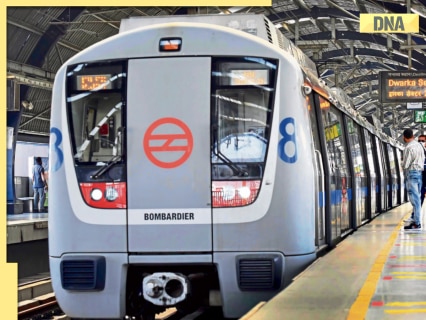DMRC takes BIG step to beat air pollution, adds 40 additional…
[ad_1]

As the Graded Response Action Plan (GRAP) Stage II has been invoked in Delhi due to rising pollution levels, the Delhi Metro Rail Corporation (DMRC) has decided to run 40 additional train trips across its corridors on weekdays to provide extra passenger capacity.
The Delhi Metro Rail Corporation(DMRC) has decided to run additional train trips across its corridors on weekdays as a step towards easing public traffic amid rising pollution levels in Delhi. The DMRC also directed the operations team to further increase the number of additional trips in case GRAP stage II is enforced by authorities in the coming days.
DMRC to run additional train trips
As the Graded Response Action Plan (GRAP) Stage II has been invoked in Delhi due to rising pollution levels, the Delhi Metro Rail Corporation (DMRC) has decided to run 40 additional train trips across its corridors on weekdays to provide extra passenger capacity. According to the DMRC spokesperson, the number of additional trips can surge to 60 in case GRAP Stage III is in place. “The move is aimed at encouraging people to use the Metro instead of their own vehicles and help mitigate the deteriorating air quality in the capital city as a collective responsibility,” the spokesperson said.
DMRC officials stated that measures to curb pollution include regular water sprinkling, wheel washing of site vehicles, covering construction material, and recycling construction waste. Around 82 anti-smog guns are deployed across sites, with more to be added as needed. DMRC claims to be a pioneer in using anti-smog guns, adopting them before they were mandated. The corporation also notes increased environmental department inspections to ensure compliance with pollution control guidelines.
Earlier, DMRC had decided to extend platforms at 32 stations to ease rush-hour congestion and improve commuter convenience. These metro stations include Noida Sector-15, 16 and 18, Golf Course and Noida City Centre on Line-3 (Blue Line), as well as Laxmi Nagar, Nirman Vihar and Preet Vihar on Line-4 (Blue Line Extension).
Delhi pollution
Meanwhile, the GRAP measures implemented in Delhi are under the direction of the Commission for Air Quality Management and in line with Supreme Court orders. The Commission for Air Quality Management (CAQM) on Tuesday announced that all commercial goods vehicles registered outside Delhi and not compliant with BS-VI emission standards will be prohibited from entering the city from November 1 in order to curb pollution.
According to the Central Pollution Control Board (CPCB), the AQI in RK Puram area of southwest Delhi remains “very poor” at 308, as of 7:00 AM on Wednesday. The AQI at Anand Vihar also remains “very poor” at 307.Ashok Vihar recorded an AQI of 302, followed by Bawana at 322, both in the “very poor” category. AQI in the Dwarka Sector 8 area remains at 298 under the “poor” category, 306 in ITO, and 294 in Nehru Nagar under the “poor” category.Around Akshardham, the AQI was recorded at 307, which also falls under the “very poor” category.
[ad_2]
Source link
